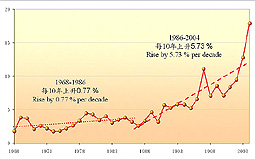 |
| Poor outlook: The Hong Kong Observatory says instances of reduced visibility have reached a record high. |

|
Visibility in Hong Kong is deteriorating over the long term, with instances of reduced visibility hitting a record high last year.
The Hong Kong Observatory released its findings on long-term visibility change today, reporting that instances of reduced visibility (below 8km, excluding cases of rain, fog and mist) were occurring more often.
Assistant Director Yeung Kai-hing said between 1968 and 1986, the percentage of time that reduced visibility occurred at the observatory rose at a rate of 0.8% per decade, while from 1986 to 2004, the rate became seven times faster, at 5.7% per decade.
"In 2004, low visibility occurred some 18% of the time, the highest on record. For February, April, June, August, September, October and December 2004, new records were set for the corresponding months," he said.
Chek Lap Kok worsens
At Hong Kong International Airport the situation was similar. Last year, reduced visibility occurred 24% of the time, the highest on record at that location. For February, May, June, August, September, October, November and December 2004, new records were set for the corresponding months.
Mr Yeung said between 1997 and 2004, reduced visibility occurred at the airport 13% of the time on average, far higher than the average of 4% observed between 1980 and 1982 at Chek Lap Kok before the new airport was built.
He said apart from fog, mist, rain and other meteorological phenomena involving water droplets, reduced visibility occurred mainly as a result of the absorption and scattering of light by particulates suspended in the atmosphere.
"In Hong Kong and other parts of southern China, suspended particulates form mainly as a result of human activities such as construction, vehicular traffic, fossil-fuel power generation, cooking and burning of vegetation," he said.
"As suspended particulates are carried and dispersed by the wind, reduced visibility is significantly influenced by meteorological factors such as wind direction, wind speed and atmospheric stability."
Autumn worst month
Seasonally, reduced visibility occurred more often in winter and spring, and less in summer and autumn. This is because Hong Kong is generally under the influence of the continental northeast monsoon in winter and spring, while under the influence of maritime southwesterly winds in summer and early autumn.
Though the percentage of time with reduced visibility was on the rise for all seasons, Mr Yeung said the most obvious change was in autumn.
"After the mid-1980s, reduced visibility became increasingly frequent in autumn, reaching 10% of the time in the last few years. This change could be due to Hong Kong experiencing northeast monsoon winds from inland in late autumn and an increase in sources of suspended particulates inland," he said.
In winter and spring, reduced visibility usually occurred in association with weak northerly surges of the monsoon or when the northeast monsoon affecting Hong Kong was subsiding.
In summer and early autumn, reduced visibility was frequently a consequence of northerly or northwesterly winds and higher atmospheric stability induced by tropical cyclones located a few hundred km east of Hong Kong.
Wind speed falls
Mr Yeung said there was no significant change in wind speeds between 1968 and 1986, but high-density urban development caused wind speeds to fall at a rate of 1.69km per hour (0.47m per second) per decade between 1986 and 2004.
While there was little change between 1968 and 1986, the frequency of westerly winds rose 3.4% per decade between 1986 and 2004.
Mr Yeung said falling wind speeds and increasing frequency of westerly winds might have contributed to the marked rise in reduced visibility at the observatory headquarters between the mid-1980s and the present day.
Last year, the observatory installed a satellite reception system to receive on a daily basis images from an imaging spectroradiometer aboard NASA's Earth Observing Satellite. Images showing the spatial coverage of smoke and haze were made available to the public through the observatory's website in November.
Recently, the observatory began further processing the satellite data received to produce images of Aerosol Optical Depth. These images show more distinctly the distribution of visibility in the Pearl River Delta, and will be available to the public on the observatory's website from today.
Go To Top
|



